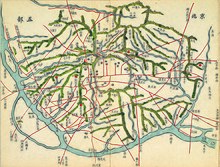Seongjeosimni
성저십리 | |
 Gyeongjo-obu-do (1861), this map shows Seongjeosimni was included in five administrative divisions of Hanseong, in late period of Joseon dynasty | |
| Alternative name | Seongjeo Shibri |
|---|---|
| Location | Seoul, South Korea |
| Type | Urban periphery |
| Part of | Hanseongbu (Korean: 한성부) |
| History | |
| Founded | 1394[1]: 94–95 |
| Periods | Joseon |
| Seongjeosimni | |
| Hangul | 성저십리 |
|---|---|
| Hanja | 城底十里 |
| Revised Romanization | Seongjeosimni |
| McCune–Reischauer | Sŏngjŏshimni |
Seongjeosimni (
History, boundary and function
Joseon
Seongjeosimni was part of the
In early period of Joseon, one of the Seongjeosimni's main function was tree farm to provide wooden materials for the national government. To achieve this policy, new settlements and deforestation were strictly prohibited in Seongjeosimni. Instead, government-led granaries to store tax payed by grains, diplomatic missions and military post for defense of the capital city filled this sparsely populated area. As there was not a notifiable group of population, national government of Joseon in early period did not have much attention on local governance of the Seongjeosimni. So, although residents in the Seongjeosimni were clearly under jurisdiction of the Hanseong, sometimes, the national government overlooked other authorities governing the adjacent local regions outside of Hanseong city to mobilize the residents in Seongjeosimni.[1]: 100–118
However, as Hanseong city's
Korean Empire and Colonial Korea
During short reign of the
Heritages and notable places
History of the Seongjeosimni can still be found in contemporary Seoul, as many of nowaday Seoul's administrative divisions have their etymological origin from that of the Seongjeosimni. This etymologic cases include Yeonhui-dong of Seodaemun District and Yongsan District.
The most prosperous region among the Seongjeosimni in late Joseon period was a place called Seogyo (서교; 西郊), corresponding to contemporary
See also
Notes and References
- ^ ISBN 9791160710670.
- .
- ^ . Retrieved 2024-02-20.
- ^ ISBN 9788994033891.
- ^ Jung, Yeo-jin; Han, Dong-soo (May 2021). "The Expansion of Administrative Districts in Gyeongseong and the Perception of the Suburbs - An Analysis of the a featured articles on the suburban areas in the newspaper, 1920~1930s -". Journal of the Korean Institute of Culture Architecture (in Korean). 74: 103–114. Retrieved 2024-02-25.
